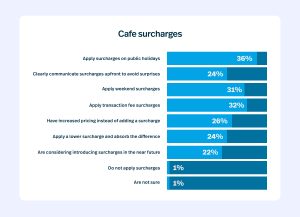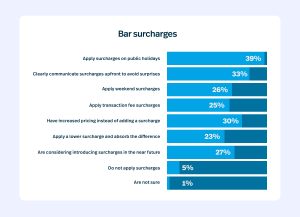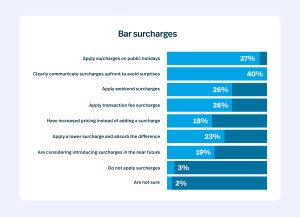
Surcharges have long sat at the centre of a hospitality tug-of-war. Customers question them. Operators rely on them. And somewhere between the two, businesses try to stay afloat.
In 2025, the debate hasn’t gone away—but it has evolved.
This year’s Lightspeed data paints a more layered picture. Surcharges aren’t being rejected outright. They’re being judged by type, context, and—crucially—how well they’re communicated. At the same time, many venues are adjusting their approach. Some are sticking with the traditional model. Others are lifting prices, absorbing costs, or experimenting with gentler ways to stay profitable.
The reality? Most diners still expect transparency. But fewer are willing to tolerate surprise fees. And that gap is where venue strategies are beginning to shift.
Let’s take a look.
- Public holiday surcharge holds strong
- Weekend surcharges – where things get murkier
- Raising prices vs surcharging
- Surcharging strategy: cafe vs. bars vs. restaurants
- The great disconnect with customers
- Caught between margin and mindset
Stay one step ahead
Lightspeed has surveyed over 1000 hospitality operators and more than 2,000 consumers to show you which dining trends are on the rise in Australia in 2025. Download the full report for free today.
Public holiday surcharge holds strong
Public holiday surcharges remain the most accepted by customers—and by a comfortable margin.
With 52% of diners saying a surcharge on public holidays is acceptable, it’s the one fee that customers not only tolerate, but understand. Rising wages, surging demand and higher operating costs on these days all contribute to that sense of fairness a surcharge fosters.
That acceptance, however, comes with a condition: clarity.
And that last figure is worth paying attention to—41%.
For many diners, it’s not the surcharge itself that stings—it’s being blindsided by it. Transparency—in this case—has the ability to smooth a potential point of friction.
Operators appear to be on the same page with 36% of venues applying a public holiday surcharge—evenly spread across restaurants, cafes, bars and hotels. It’s one of the few areas where the relationship between customer and venue remains mostly intact.
Weekend surcharges—where things get murkier
Weekend and transaction surcharges are a different story.
This is the second-highest rate of disapproval across all surcharge types. Numbers like this suggest that, for many customers, weekends aren’t special—they’re standard. Charging more to trade on the busiest days of the week doesn’t sit right.
These are growing points of tension. So, what helps ease them?
As with public holiday surcharges, the olive branch comes in the form of communication. Around 19% of customers say they’ll accept a service charge for large groups, rising to 30% for weekend surcharges, but only if the surcharge is communicated clearly.
The lesson? It’s not always the surcharge itself. It’s the friction it causes when it appears without warning.
See the data in action
Engage with interactive breakdowns of key hospitality trends across Australia.
Raising prices vs surcharging
In response to this growing customer resistance, some venues are pivoting—not by removing surcharges entirely, but by making them quieter.
Of the merchants surveyed, 24% say they’ve raised their prices instead of applying a formal surcharge, while another 23% report applying a smaller surcharge and absorbing the rest themselves. It’s a shift in tone, aimed at preserving margins without putting friction on the bill.
And let’s be clear, these moves aren’t about hiding costs. They’re about avoiding confrontation while maintaining sustainable margins. In an environment where customers are increasingly fee-sensitive, venues need to recover costs without eroding trust.
It goes without saying that this is a delicate balance. Raise your flat white by a few cents and, while some customers make a fuss, most customers shrug. Add a 1.5% card surcharge at the till and you risk a rebellion (or at least a 1-star Google review).
That difference—between perception and principle—is driving the rise of these more subtle strategies.
Surcharging strategy: cafe vs. bars vs. restaurants
Venue type matters too. The surcharge conversation plays out differently in a cafe than it does in a wine bar or fine dining restaurant.
Here’s how it breaks down.
Cafes
Cafes lead in applying card surcharges at 32% and are also more likely to raise prices quietly at 26%.
And it makes sense.
With generally lower revenue than restaurants or bars, cafes feel the impact of transaction fees more acutely. Without a surcharge in place, those small, per-transaction costs can add up quickly—eating into annual profits. 
A few cents is relatively minor to the customer, who only pays it once a day—but for the venue, it’s a cost they wear on every transaction, all day long.
And that’s why raising prices is a savvy move.
Raising prices can cover these surcharges without angering their customer base the way a card surcharge can. It’s an approach built around simplicity—avoiding awkward conversations at the counter by keeping transactions fast and friction-free.
Bars
Bars are keeping their options open with 27% saying they’re considering introducing surcharges—more than any other venue type. It’s a sign this segment is comfortable in feeling things out, experimenting with what customers will accept and what the margins demand.
Bars tend to have higher spends per head—compared to cafes—more shared tabs and a bit more chaos when it comes to how and when people pay. That variability means the strategy has to have some room to flex.
The point is: bars are testing the waters.
Restaurants
Restaurants, on the other hand, are the kings of transparency with 40% of restaurant operators saying they actively disclose their surcharges—the highest across all venue types.
Restaurants are where expectations are clearest. It’s where bookings are made, menus are studied and the experience is likely more deliberate from the moment someone walks through the door. So when there’s an extra charge, it wouldn’t make sense to hide it—that could ruin a finely-tuned experience.
And it works.
When diners are told early—on the menu, on the booking confirmation, at the start of service—they’re far more likely to accept the surcharge without complaint (30%). It doesn’t interrupt the experience. It simply becomes part of it.
The great disconnect with customers
In analysing the data, there is one truth that has made itself absolutely clear: customers don’t like surcharges.
Huge shock, right?
Beyond public holidays—where more than half of diners are on board—every other surcharge type faces more rejection than approval. Weekend fees, transaction costs, group service charges—they’re all pushing against public sentiment.
And this breeds tension.
From the customer’s point of view, these surcharges have the potential to feel arbitrary. An annoyance. A surprise on the bill. But from the venue’s point of view? They’re far more linked to survival.
This is no more apparent than when it comes to adding a surcharge for large groups.
This surcharge is standard practice in many restaurants—used to cover the extra strain that big bookings place on the kitchen, the floor staff and the overall flow of service. But only 23% of customers say they’re acceptable, while a full 73% say they’re not.
This disconnect is huge
What seems like common sense to a business—charging more to serve a table of 14—can feel like a penalty to the group just trying to celebrate a birthday.
Why? Because the cost doesn’t feel like something the customer should have to pay. They’re already paying for a product, why should they pay for a business’s financial fees too?
But here’s the thing: venues generally don’t add surcharges to boost their profits. They add them to stay open. And that’s the nuance that often gets lost. In a business where margins are razor-thin and overheads only go one way, passing on some of those costs is a necessity—not a luxury.
The challenge seems to lie in making customers see the full picture. And unless that picture is made clearer—through smarter communication, context or baked-in alternatives—some surcharges will continue to land the wrong way.
Caught between margin and mindset
If there’s one thing this year’s data makes clear, it’s this: surcharges come in many different guises and have a canny ability to divide opinion.
Venues themselves can’t afford to abandon them though. And so, they must evolve them. Whether that’s via testing new strategies, or paying more close attention to what customers are open to accepting—and when they push back.
The operators who get it right? They’re the ones who understand that covering costs is essential—but how you do it matters just as much.
So whether you’re sticking with a traditional surcharge, trialling a price increase or absorbing part of the cost to keep the peace, the rule is the same:
Clarity builds trust and strategy protects your margin.
And the smartest venues will be the ones who can do both.
Want to explore the data for yourself?
Dive into the full interactive report to see the insights behind the headlines.

News you care about. Tips you can use.
Everything your business needs to grow, delivered straight to your inbox.


